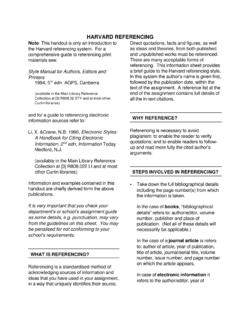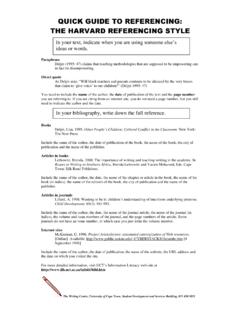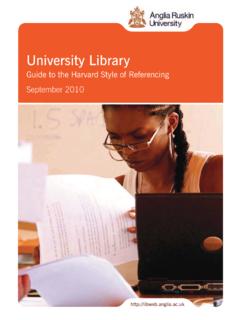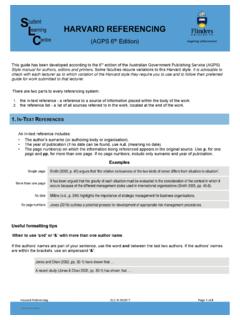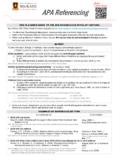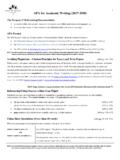Transcription of LIBRARIES AND LEARNING The Harvard system of referencing
1 LEARNING . RESEARCH. GUIDANCE. RESOURCES. SPACE. LIBRARIES AND LEARNING . The Harvard system of referencing Contents 1. Introduction .. 3. Plagiarism .. 3. Citation styles .. 3. Collecting and organising references .. 4. Dates and page numbers .. 4. PDFs .. 4. 2. Citations in the text .. 5. Secondary referencing .. 5. Information found in more than one source .. 5. 3. Reference List/Bibliography .. 6. References books (including electronic books) .. 6. References other sources .. 7. Journal articles (including electronic journals) .. 7. Newspapers (including electronic newspapers) .. 8. Systematic reviews .. 8. Images and diagrams .. 8. Conference proceedings .. 9. Publications from a corporate body (including Government publications).
2 9. Legislation (including Acts of Parliament, Statutory Instruments) .. 9. Market research reports .. 10. British Standards .. 10. Theses and dissertations .. 10. Exhibitions .. 10. Music scores .. 10. 0116 257 7042 1. References live performances .. 11. Dance .. 11. Play .. 11. References electronic or audiovisual .. 11. Web pages .. 11. Computer games .. 11. Software .. 12. E-mails from a public domain .. 12. Weblogs (blogs) .. 12. Wikis .. 12. Social networking sites (Facebook, Twitter, Bebo etc) .. 12. Media (video, film or broadcast) .. 13. Online films .. 13. Podcasts .. 13. Online images .. 13. References personal communication .. 14. Lecture notes on Blackboard .. 14. References - reference works.
3 14. Dictionaries/encyclopaedias .. 14. Classical works .. 15. 4. Further information .. 15. 0116 257 7042 2. The Harvard system of referencing This is a guide to the Harvard system but you should always check your course handbook and/or module outline for any further guidance, as your lecturers may prefer a different style of referencing . The guide covers most sources you are likely to use, but if you have any queries, further help is available either at the first floor information desk in the Kimberlin Library, or by emailing 1. Introduction When writing a piece of work you should provide references to the sources used. A reference is the detailed bibliographic description of the item from which you gained your information.
4 In simple terms, this means the details of the items that you have used, author, title, date of publication. References are briefly cited within the text, and then given in full at the end of your work in a reference list. Any other items read for background information but not referred to in the text should be given in full at the end of your work in a bibliography. References are used to: Enable the reader to locate the sources you have used;. Help support your arguments and provide your work with credibility;. Show the scope and breadth of your research;. Acknowledge the source of an argument or idea. Failure to do so could result in a charge of plagiarism. Plagiarism Plagiarism is defined by De Montfort University Student Regulations as the significant use by a student of other people's work and the submission of it as though it were his or her own.
5 Citation styles Various citation styles exist. They convey the same information, only the presentation of that information differs. Most style guides fall into two commonly used systems: author-date system ( Harvard );. numeric system ( Vancouver, MLA, IEEE). Whichever system you use, it is important that you are consistent in its application. This guide is intended to provide you with advice on how to use the Harvard (author-date) system , where you supply the author's name and the date of publication of the document referred to within the text. In order to find out more about the document a reader can simply look up the author's name in the reference list. 0116 257 7042 3. Collecting and organising references It is often not easy (or possible) to retrieve sources after you have written your text.
6 For this reason it is best to keep a good record of everything you use. Reference management software, such as RefWorks, Mendeley or Zotero, will help you organise your references according to different citation systems and to add the citations to your text. For further information about reference management and for help in using RefWorks, please see our reference management guide at: A note about dates and page numbers If no date can be established you can use Webb ( ). If the date can be established but only approximately you should use c. Webb ( ). Electronic books read via an e-reader such as the Kindle do not have traditional page numbers. In this case, use the chapter numbers instead for indicating the location of a quoted section: Jones (2016, chapter 6) states that.
7 If you wish to cite a web resource that does not include page numbers, you can include any of the following in the text to cite the quotation: A paragraph number, if provided; alternatively, you could count paragraphs down from the beginning of the document: British Medical Association (2014, para. 2) states An overarching heading plus a paragraph number within that section: NHS (2014, Migraines, para. 3) states A short title in quotation marks, in cases in which the heading is too unwieldy to cite in full: NHS (2014, Risks section, Driving and mobile phones ) states PDFs A PDF is a format rather than a type of resource. You should reference this according to the source type, but if this is not possible, you can reference as a website.
8 0116 257 7042 4. 2. Citations in the text All ideas taken from another source regardless of whether directly quoted or paraphrased must be referenced in the text of your assignment. To link the information you use in your text to its source (book, article, etc.), put the author's name and the year of publication at the appropriate point in your text. If the author's name does not naturally occur in your writing, put the author's surname and date in brackets. So if the authors name is James Robert Jones, you would use the surname Jones and the date to cite in the text. There is some evidence (Jones, 2016) that these figures are incorrect. If the author's name is part of the statement, put only the year in brackets: Jones (2016) has provided evidence that these figures are incorrect.
9 If there are two or three authors, give all: It is claimed that the political market is more complex than just voters (Lees and Marshment, 2014, p3). Note: if you are giving a direct quotation you need to include the page number. If there are more than three authors, cite only the first followed by et al.' (which means and others'): The amount of data in all domains is expanding, how can we ensure efficient working practices? (Karau et al., 2015). If an author has published more documents in the same year, distinguish between them by adding lower- case letters: In recent studies by Smith (2016a, 2016b, 2016c) . Secondary referencing When an author quotes or cites another author and you wish to cite the original author you should first try to trace the original item.
10 However, if this is not possible, you must acknowledge both sources in the text, but only include the item you actually read in your reference list. If Jones discusses the work of Smith you could use: Smith (2015) as cited by Jones (2016). or Smith's 2015 study (cited in Jones, 2016) shows that . Then cite Jones in full in your reference list. Information found in more than one source If you find information in more than one source, you may want to include all the references to strengthen your argument. In this case, cite all sources in the same brackets, placing them in order of publication date (earliest first). Separate the references using a semi-colon(;). Several writers (Jones, 2014; Biggs, 2015; Smith, 2016) argue.
